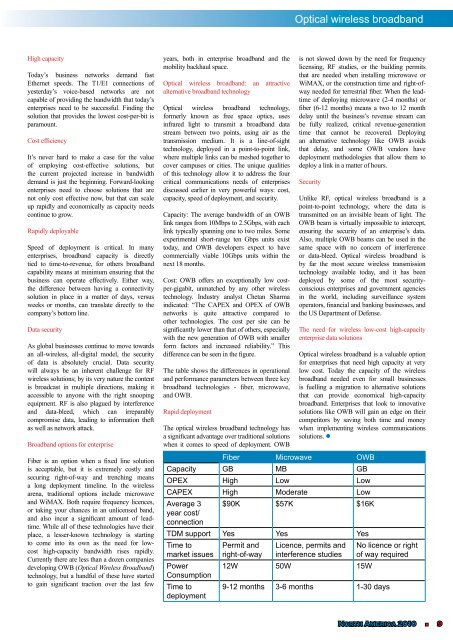As the workforce becomes wireless so does the ... - Connect-World
As the workforce becomes wireless so does the ... - Connect-World
As the workforce becomes wireless so does the ... - Connect-World
You also want an ePaper? Increase the reach of your titles
YUMPU automatically turns print PDFs into web optimized ePapers that Google loves.
Optical Mobile <strong>wireless</strong> payment Mobile broadband systemsaccessHigh capacityToday’s business networks demand fastE<strong>the</strong>rnet speeds. The T1/E1 connections ofyesterday’s voice-based networks are notcapable of providing <strong>the</strong> bandwidth that today’senterprises need to be successful. Finding <strong>the</strong><strong>so</strong>lution that provides <strong>the</strong> lowest cost-per-bit isparamount.Cost efficiencyIt’s never hard to make a case for <strong>the</strong> valueof employing cost-effective <strong>so</strong>lutions, but<strong>the</strong> current projected increase in bandwidthdemand is just <strong>the</strong> beginning. Forward-lookingenterprises need to choose <strong>so</strong>lutions that arenot only cost effective now, but that can scaleup rapidly and economically as capacity needscontinue to grow.Rapidly deployableSpeed of deployment is critical. In manyenterprises, broadband capacity is directlytied to time-to-revenue, for o<strong>the</strong>rs broadbandcapability means at minimum ensuring that <strong>the</strong>business can operate effectively. Ei<strong>the</strong>r way,<strong>the</strong> difference between having a connectivity<strong>so</strong>lution in place in a matter of days, versusweeks or months, can translate directly to <strong>the</strong>company’s bottom line.Data security<strong>As</strong> global businesses continue to move towardsan all-<strong>wireless</strong>, all-digital model, <strong>the</strong> securityof data is ab<strong>so</strong>lutely crucial. Data securitywill always be an inherent challenge for RF<strong>wireless</strong> <strong>so</strong>lutions; by its very nature <strong>the</strong> contentis broadcast in multiple directions, making itaccessible to anyone with <strong>the</strong> right snoopingequipment. RF is al<strong>so</strong> plagued by interferenceand data-bleed, which can irreparablycompromise data, leading to information <strong>the</strong>ftas well as network attack.Broadband options for enterpriseFiber is an option when a fixed line <strong>so</strong>lutionis acceptable, but it is extremely costly andsecuring right-of-way and trenching meansa long deployment timeline. In <strong>the</strong> <strong>wireless</strong>arena, traditional options include microwaveand WiMAX. Both require frequency licences,or taking your chances in an unlicensed band,and al<strong>so</strong> incur a significant amount of leadtime.While all of <strong>the</strong>se technologies have <strong>the</strong>irplace, a lesser-known technology is startingto come into its own as <strong>the</strong> need for lowcosthigh-capacity bandwidth rises rapidly.Currently <strong>the</strong>re are less than a dozen companiesdeveloping OWB (Optical Wireless Broadband)technology, but a handful of <strong>the</strong>se have startedto gain significant traction over <strong>the</strong> last fewyears, both in enterprise broadband and <strong>the</strong>mobility backhaul space.Optical <strong>wireless</strong> broadband: an attractivealternative broadband technologyOptical <strong>wireless</strong> broadband technology,formerly known as free space optics, usesinfrared light to transmit a broadband datastream between two points, using air as <strong>the</strong>transmission medium. It is a line-of-sighttechnology, deployed in a point-to-point link,where multiple links can be meshed toge<strong>the</strong>r tocover campuses or cities. The unique qualitie<strong>so</strong>f this technology allow it to address <strong>the</strong> fourcritical communications needs of enterprisesdiscussed earlier in very powerful ways: cost,capacity, speed of deployment, and security.Capacity: The average bandwidth of an OWBlink ranges from 10Mbps to 2.5Gbps, with eachlink typically spanning one to two miles. Someexperimental short-range ten Gbps units existtoday, and OWB developers expect to havecommercially viable 10Gbps units within <strong>the</strong>next 18 months.Cost: OWB offers an exceptionally low costper-gigabit,unmatched by any o<strong>the</strong>r <strong>wireless</strong>technology. Industry analyst Chetan Sharmaindicated: “The CAPEX and OPEX of OWBnetworks is quite attractive compared too<strong>the</strong>r technologies. The cost per site can besignificantly lower than that of o<strong>the</strong>rs, especiallywith <strong>the</strong> new generation of OWB with smallerform factors and increased reliability.” Thisdifference can be seen in <strong>the</strong> figure.The table shows <strong>the</strong> differences in operationaland performance parameters between three keybroadband technologies - fiber, microwave,and OWB.Rapid deploymentThe optical <strong>wireless</strong> broadband technology hasa significant advantage over traditional <strong>so</strong>lutionswhen it comes to speed of deployment. OWBis not slowed down by <strong>the</strong> need for frequencylicensing, RF studies, or <strong>the</strong> building permitsthat are needed when installing microwave orWiMAX, or <strong>the</strong> construction time and right-ofwayneeded for terrestrial fiber. When <strong>the</strong> leadtimeof deploying microwave (2-4 months) orfiber (6-12 months) means a two to 12 monthdelay until <strong>the</strong> business’s revenue stream canbe fully realized, critical revenue-generationtime that cannot be recovered. Deployingan alternative technology like OWB avoidsthat delay, and <strong>so</strong>me OWB vendors havedeployment methodologies that allow <strong>the</strong>m todeploy a link in a matter of hours.SecurityUnlike RF, optical <strong>wireless</strong> broadband is apoint-to-point technology, where <strong>the</strong> data istransmitted on an invisible beam of light. TheOWB beam is virtually impossible to intercept,ensuring <strong>the</strong> security of an enterprise’s data.Al<strong>so</strong>, multiple OWB beams can be used in <strong>the</strong>same space with no concern of interferenceor data-bleed. Optical <strong>wireless</strong> broadband isby far <strong>the</strong> most secure <strong>wireless</strong> transmissiontechnology available today, and it has beendeployed by <strong>so</strong>me of <strong>the</strong> most securityconsciousenterprises and government agenciesin <strong>the</strong> world, including surveillance systemoperators, financial and banking businesses, and<strong>the</strong> US Department of Defense.The need for <strong>wireless</strong> low-cost high-capacityenterprise data <strong>so</strong>lutionsOptical <strong>wireless</strong> broadband is a valuable optionfor enterprises that need high capacity at verylow cost. Today <strong>the</strong> capacity of <strong>the</strong> <strong>wireless</strong>broadband needed even for small businessesis fuelling a migration to alternative <strong>so</strong>lutionsthat can provide economical high-capacitybroadband. Enterprises that look to innovative<strong>so</strong>lutions like OWB will gain an edge on <strong>the</strong>ircompetitors by saving both time and moneywhen implementing <strong>wireless</strong> communications<strong>so</strong>lutions. •Fiber Microwave OWBCapacity GB MB GBOPEX High Low LowCAPEX High Moderate LowAverage 3 $90K $57K $16Kyear cost/connectionTDM support Yes Yes YesTime tomarket issuesPowerConsumptionTime todeploymentPermit andright-of-wayLicence, permits andinterference studies12W 50W 15WNo licence or rightof way required9-12 months 3-6 months 1-30 daysNorth America 2010 • 9
















